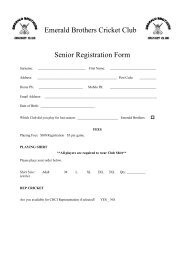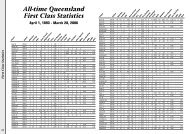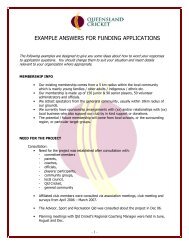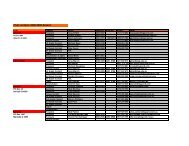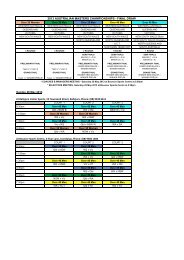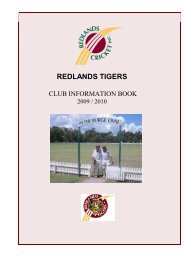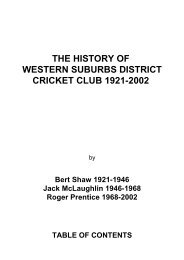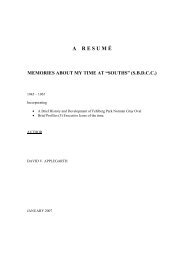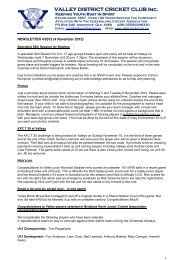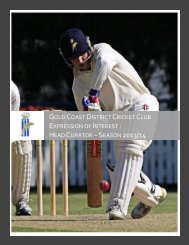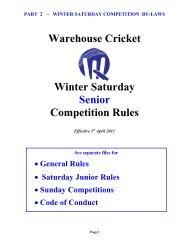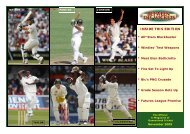QCSA Handbook on scoring 2010 - Queensland Cricket
QCSA Handbook on scoring 2010 - Queensland Cricket
QCSA Handbook on scoring 2010 - Queensland Cricket
- No tags were found...
Create successful ePaper yourself
Turn your PDF publications into a flip-book with our unique Google optimized e-Paper software.
The match details are recorded at the top, and the <strong>scoring</strong> shots are brokendown <strong>on</strong> bottom left. On the back there is provisi<strong>on</strong> to record all wicketpartnerships that the batter was involved in, and milest<strong>on</strong>e details.A blank wag<strong>on</strong> wheel, showing both sides, is in the Appendices (page 91).Calculating target scoresWhen play is interrupted during a limited overs match (usually because ofweather, but a determined streaker could also do the trick), the number ofovers for either team may have to be revised to a lesser number, providedthat both teams have the opportunity to bat for a preset minimum (e.g. 15overs each in a scheduled 50 over match, 5 overs each in a Twenty20match).At higher levels of cricket (including first class, and First Grade in thePremier Grade competiti<strong>on</strong>), the Duckworth/Lewis method is used todetermine target scores. This is calculated using a specially designedcomputer program, and will usually be d<strong>on</strong>e by match coordinators — notby the scorers! You will, however, be provided with the calculati<strong>on</strong>s so thatyou are aware of what the target is for the team batting sec<strong>on</strong>d.Duckworth/Lewis provides a complete breakdown of what score Team Bmust have accumulated at any stage during its innings, should furtherinterrupti<strong>on</strong>s occur. But always be aware that Duckworth/Lewis provides the‘par’ score. This means that if Duckworth/Lewis says that Team B must be4-250 after 38 overs, you must add 1. Therefore they will need to be 4-251.For levels of cricket below those that use Duckworth/Lewis, the target scorefor the team batting sec<strong>on</strong>d is worked out manually — and yes, you willprobably be asked to do this! To assist you, there are tables available to helpyou calculate the ‘discounted total runs’ from Team A’s innings to achievethe target for Team B. Again, the discounted total runs give you a par score,so you must add 1.72Target calculati<strong>on</strong> works by breaking down each over faced by Team Aaccording to the number of runs scored off it. The calculati<strong>on</strong> then startsfrom the minimum overs required for Team B to c<strong>on</strong>stitute a match (e.g. 15overs for a scheduled 50 over game). You take the 15 overs that scored themost runs, discount the total runs by 82.5%, which gives you the ‘par’ scorethat Team B must be after 15 overs. You then c<strong>on</strong>tinue that calculati<strong>on</strong>, withgradually decreasing discounts, up to the full 50 overs.<strong>Queensland</strong> <strong>Cricket</strong> Scorers Associati<strong>on</strong>



